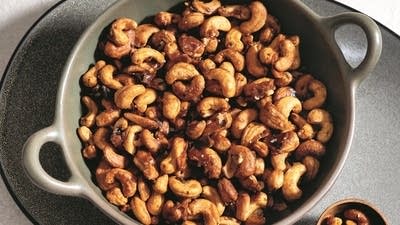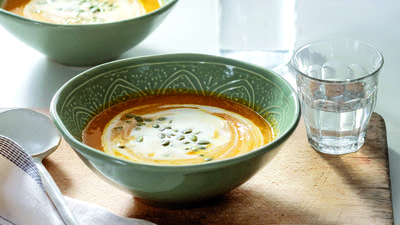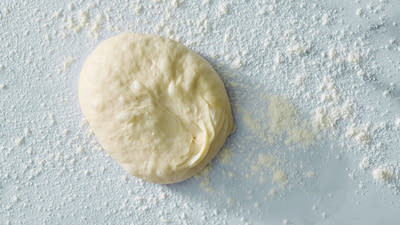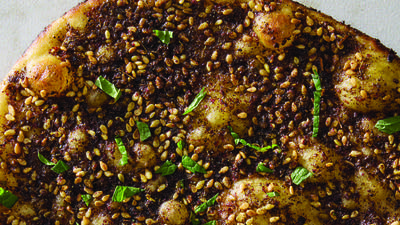
Raghavan Iyer is a bestselling cookbook author, culinary educator, spokesperson and consultant who specializes in Indian cuisine. He takes pride in creating recipes from common ingredients, using combinations and flavor-extraction techniques to give his dishes unique flavors. In this installment of The Key 3, he shares with Lynne Rossetto Kasper the techniques behind three of his classic recipes: Smoky Yellow Split Peas, Sweet-scented Pilaf and Indian Slaw. His latest book is Indian Cooking Unfolded.
Here are Iyer's keys, as told to Lynne:
With Indian food, to me it's all about colors, it's textures, it's aromas, it's temperatures. You eat with all your senses. I've had people say, “Indian food -- it's all yellow, it's all the same.” First of all, curry powder ain’t Indian food. Second of all, to me the beauty of Indian food is creating complexity with not a bajillion spices, but maybe just one or two spices treated in such a way that you're going to end up with a complexity that just blows your mind.
1. Smoky Yellow Split Peas: Tamatar Chana Dal
 Smoky Yellow Split Peas
Smoky Yellow Split Peas
The kind of dal we're doing today is done with yellow split peas. The variety of yellow split peas in India is slightly different, but look very similar to the variety that you find here. We call it Chana Dal in India, which is actually black garbanzo beans that have been split and the skins have been removed.
What I've done so far is wash the peas. I'm just adding water to it, no broth. Often people say, "Well, why are you doing that without broth?" Because if you think about it, the divas in Indian cooking really are the spices. You don't need broth because the spices really shine.
What I want to prove in this dish is first of all, the simplicity of it, 10 ingredients or fewer, and that it is about going to the main grocery store and just getting what we're familiar with -- potatoes, onions, chiles, cilantro, and so on.
You look at one spice, which is ground turmeric. Students in the past go, “Ew, curry.” I say, “Ew, not.” Ground turmeric gives commercial curry powders that notorious yellow color.
Four hundred years ago, when the English were in India, they fell in love with some of the sauces in the Southeast and the Northwest. They had their cooks put together a cornucopia of ingredients that they ground and put in a jar labeled “curry powder.” But as a concept, you do not have curry powders in India. To us, in a nutshell, if it doesn't have a sauce, it's not a curry. Not all curries have turmeric either. So in essence, a dal to us is a legume curry -- because it's saucy just like you and me.
In this dish we've got turmeric; that will continue to cook and add color and flavor to the peas. It will come to a boil and then we're going to get rid of some of the foam that sort of separates naturally as part of the cooking process. This creates a sauce that is a little bit clearer. One of the schools of thought is that it helps you digest it much better -- which, when talking to some of the food scientists, certainly could be debatable.
We're going to go ahead and add some potatoes, diced about half-an-inch. We're going to just let that continue to simmer and we're going to do that covered; that will cook the potatoes. While that is doing its thing, we're going to look at building the flavors in this pot. To this dish all we're going to do is add three spices, one is cumin seed.
I always say buy spices as much as possible in the entire seed form. If you give whole spices to a good Indian cook, he or she should be able to extract eight flavors from a given spice, depending on what you do with it.
We're going to add some coriander seeds, about a tablespoon. It's actually a distant member of the citrus family; when you grind it, it intensifies its citrus quality.
We're adding some chilies to this; these are whole chilies. We're going to go ahead and toast these. There's no oil. To this we're going to add the whole spices. When you're toasting spices, you're looking for the first color change and the first aroma change. You can hear that sizzle that is happening without the oil.
You can see what's happened very quickly: they're darkening, they have changed, this is all we're looking for right now. You can see the chilies have blackened. We're going to take this and we're going to add it right to a blender jar. Then to create a liquid base for that, we're going to add some tomatoes to it. Then we will puree all of that together.
There's a smokiness that comes through. This is what's going to flavor our legume curry. Once the potatoes are done, we are adding this.
It is a gorgeous dish -- this is what blankets rice. You're tasting the complexity that's coming through. It's a marriage that really works very well with this dish.
Ingredients
1 cup yellow split peas
1 pound potatoes (Yukon gold or russet), peeled, and cut into 1/2-inch cubes (soak them in cold water to prevent browning; drain before use)
1/4 teaspoon ground turmeric
2 to 4 dried red cayenne chiles (like chile de arbol), stems discarded
1 tablespoon coriander seeds
1 teaspoon cumin seeds
1 medium-size tomato, cored, and diced
2 tablespoons finely chopped fresh cilantro leaves and tender stems
1 1/2 teaspoons coarse kosher or sea salt
Procedure
1. Measure the peas into a medium-size saucepan. Cover it up with water and rinse the grains by rubbing them in-between your fingertips (I just use the fingers of one hand to do it). The water will become cloudy and may have some debris like the odd skin from the peas (even though they are skinless) or dust from the packaging. Drain this water. Repeat three to four times until the water, upon rinsing the peas, remains clearer. Measure and pour 4 cups water into the pan and bring it to a boil over medium-high heat. You will see some foam arise; scoop it out and discard it.
2. Add the potatoes and turmeric to the peas, stirring once or twice. Lower the heat to medium-low and cover the pan. Stew the mélange, stirring occasionally, until the peas are tender but still firm-looking and the potatoes are cooked, 20 to 25 minutes.
3. While the peas and potatoes cook, preheat a small skillet over medium-high heat. Once the pan feels hot (a palm held close to the bottom will feel the heat), usually will take 2 to 4 minutes, sprinkle the chiles, coriander, and cumin into it. Toast the spices, shaking the pan very frequently, until the chiles blacken and smell smoky- hot and the seeds turn reddish brown and smell incredibly aromatic (nutty with citrus undertones), 1 to 2 minutes. Transfer this spice blend to a blender jar and plunk in the tomato. Puree, scraping the insides of the jar as needed, to make a smooth, reddish brown paste with a smoky aroma that is sure to knock your socks off.
4. Once the peas are cooked, scrape the spicy (as in well-seasoned) tomato paste into the pan. I usually pour some of the liquid from the pan into the blender jar and process it for a brief second to wash out all the goodness into the water. Pour the washings back into the pot. Stir in the cilantro and salt.
5. Crank up the heat to medium-high and vigorously boil the dal, uncovered, stirring occasionally, to allow the flavors to mingle and the sauce to slightly thicken, 12 to 15 minutes. If you wish for a thicker sauce, mash some of the peas and potatoes with the back of your spoon. Serve warm.
Tips
Even though dals are great draped over a bed of steamed rice, try them with wedges of flatbread dunked in it. Even when crusty baguette or other yeast breads are warmed, sliced, and served alongside, it makes a great appetizer.
Yellow split peas that are available here in the US in every supermarket but are slightly different than the variety that grows in India -- I find those grown here to be a bit nuttier and very much corn-like in texture. The ones in India are from a variety of garbanzo beans that have a dark brown to almost blackish colored skin. When the legume's skin is removed and the grain split in half, you get the variety of yellow split peas in India called chana dal. The green split peas (what you generally use for split pea soup with ham hock) are a perfect stand-in for the yellow variety should you wish to use them instead.
Puree any leftover dal in a blender or a food processor to yield an almost pate-like spread. Try and drain off a bit of the excess liquid before you do that. It reminds me of a Greek skordalia (potato puree with garlic) but with more texture and oomph.
2. Sweet-Scented Pilaf: Masala Pulao
 Sweet-Scented Pilaf
Sweet-Scented Pilaf
Perfuming oils with whole spices has been classic to north Indian cuisine for thousands of years (no, I am not exaggerating). Western cultures call it blooming but we call it tadka. Whatever the nomenclature for this technique, the results play a pleasing game of how- much-can-you-eat-without-stopping with your palate. Give in and savor it as a side to any main dish, salad, soup, or even a starter.
Ingredients
1 cup white Indian or Pakistani basmati rice
2 tablespoons Ghee (homemade or store-purchased) or canola oil
1 teaspoon cumin seeds
1/2 teaspoon whole cloves
6 green or white cardamom pods
2 fresh or dried bay leaves
2 cinnamon sticks (each 3-inches long)
1 small red onion, cut in half lengthwise and thinly sliced
1 teaspoon coarse kosher or sea salt
Procedure
1. Place the rice in a medium-size bowl. Fill the bowl halfway with water, to cover the rice. Gently rub the slender grains between the fingers of one hand, without breaking them, to wash off any dust or light foreign objects (like loose husks), which will float to the surface. The water will become cloudy. Drain this water (you don't need a colander for this. I just tip the bowl over the sink to pour off the water making sure the rice stays in the bowl.) Repeat three or four times, until the water, after you rinse the grains, remains relatively clear; drain. Now fill the bowl halfway with cold water and let it sit at room temperature until the kernels soften, 20 to 30 minutes; drain.
2. Heat the ghee in a medium-size saucepan over medium-high heat. Once it appears to shimmer, sprinkle in the cumin, cloves, cardamom, bay leaves, and cinnamon. The spices will sizzle, turn reddish brown, crackle, and scent the air with sweet aromas, 30 seconds to 1 minute. Add the onion and stir-fry the slices until they are lightly brown around the edges, 3 to 5 minutes.
3. Add the drained rice, and coat the grains with the onion and whole spices by tossing them together gently. Pour in 1½ cups cold tap water, and sprinkle in the salt. Stir the rice once or twice to incorporate the ingredients. Allow the water to boil, uncovered, still over medium-high heat, until it has evaporated from the surface and craters are starting to appear in the rice, 5 to 8 minutes. Now (and not until now) stir once or twice to bring the partially cooked layer from the bottom of the pan to the surface. Cover the pan with a tight-fitting lid and reduce the heat to the lowest possible setting. Steep for 8 to 10 minutes (8 for an electric burner, 10 for a gas burner). Then turn off the heat and let the pan stand on that burner, undisturbed, for an additional 10 minutes.
4. Uncover the pan, fluff the rice with a fork, and serve. You may choose to remove the cloves, bay leaves, cardamom, and cinnamon before you serve. I usually leave them in since they continue to perfume the rice and just instruct the folks eating the rice to watch for those whole spices and eat around them.
Tips
The whole spices used here are some of the most common spices used in some of the versions of Garam masala. Here they are left whole, gently infusing nutty clarified butter with subtle aromas and tastes. Great proof that not all garam masalas are ground in northern India.
3. Indian Slaw: Bund Gobhi Nu Shaak
 Indian Slaw
Indian Slaw
Unless your mama is from western India, chances are this is not your mother's mayo- smothered, garlic powder-ridden coleslaw. Nutty, tart, with a citrus burst, these crunchy shreds of cabbage pack just the right amount of heat from the fairly benign Serrano chiles. Serve it, as is, for a salad course, or as an accompaniment to your traditional picnic fare. For an elegant presentation, I often serve it after the appetizer course mounded on top of romaine heart leaves with an edible flower as garnish, when seasonal.
Ingredients
1/2 small head of cabbage (about 1 pound) or 1 bag (14 ounces) coleslaw mix
1 to 2 fresh green Serrano chiles, stems discarded
1/4 cup dry-roasted peanuts
1/4 cup dry unsweetened coconut shreds (see tips)
1/4 cup finely chopped fresh cilantro leaves and tender stems
1 1/2 teaspoons coarse kosher or sea salt
Juice from 1 medium-size lime 2 tablespoons canola oil
1 teaspoon black or yellow mustard seeds 1/4 teaspoon ground turmeric
Procedure
1. Remove the tough rib from the lower center of the halved cabbage by slicing it through, ending up with a v-shaped opening at the base. Cut the cabbage in half lengthwise. Slice it into shreds, as thin as you can. Dump them into a large bowl. If using the pre-shredded coleslaw blend (which usually has a few shreds of carrots and purple cabbage in it for color), empty the bag's contents into a large bowl.
2. Slice the chiles lengthwise and then cut them into thin slices, crosswise, ending up with half-moons of chiles that still have the rib and seeds within. Do not discard the seeds. Add this to the cabbage.
3. Empty the peanuts into a spice grinder (like a coffee grinder), food processor's bowl, or mini chopper and pulse the nuts to a consistency of coarse bread crumbs. Letting the machine run incessantly may yield a gummy product that you know more commonly as peanut butter. Tip the contents of the grinder over the cabbage. Add the coconut, cilantro, salt, and lime juice.
4. Heat the oil in a small skillet over medium-high heat. Once the oil appears to shimmer, add the mustard seeds, cover the pan, and cook until the seeds have stopped popping (not unlike popcorn), about 30 seconds. Remove the pan from the heat and sprinkle in the turmeric which instantly bathes the oil with its yellow hue, the heat just right in cooking the spice without burning it. Pour this popcorn-smelling mélange over the cabbage. I often grab some of the cabbage from the bowl and add it to the skillet, wiping it clean with the shreds to make sure I get every last bit of spice and oil. Thoroughly combine the contents in the large bowl (tongs, spoons, or my favorite -- clean hand) to ensure every shred is evenly coated with everything. Serve either at room temperature (my preference) or chilled.
Tips
A decent-sized supermarket, worth its weight in gold, should stock dried unsweetened coconut either in the health foods aisle or the baking section. If they don't, grab that bag of highly sweetened coconut shreds in the baking shelf that is often a key ingredient in coconut cream pies and other coconut-based desserts like macaroons (my weakness.) To use it in this recipe, dump 1/2 cup of the sugary shreds into a medium-size bowl. Cover it with water and run your fingers through to wash some of the sugar. Empty this into a fine-meshed colander (think tea strainer). Dump the coconut back into the bowl and repeat with the rinsing, washing, and straining. You may need to do this cycle three to four times to make sure all that sugar is gone. An underlying sweetness is fine since freshly shredded coconut does have an inherent sweet taste.
I am a sucker for cooked cabbage. Oftentimes with the leftover salad I will add it to a skillet with a little water to cover the bottom of the pan and heat the cabbage until it warms through. A little extra kick from a liberal sprinkling of ground red pepper (cayenne) takes care of my addiction for nutty, hot, crisp-tender cabbage until the next fix.
Peanut allergy sufferers, if you are alright with any other nuts, use them as alternatives.

The Key 3 is a series of discussions with great cooks (not just professional chefs) about the three recipes or techniques they think everyone should know.
Before you go...
Each week, The Splendid Table brings you stories that expand your world view, inspire you to try something new, and show how food connects us all. We rely on your generous support. For as little as $5 a month, you can have a lasting impact on The Splendid Table. And, when you donate, you’ll join a community of like-minded individuals who love good food, good conversation, and kitchen companionship. Show your love for The Splendid Table with a gift today.
Thank you for your support.
Donate today for as little as $5.00 a month. Your gift only takes a few minutes and has a lasting impact on The Splendid Table and you'll be welcomed into The Splendid Table Co-op.



